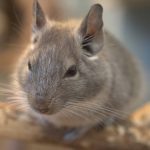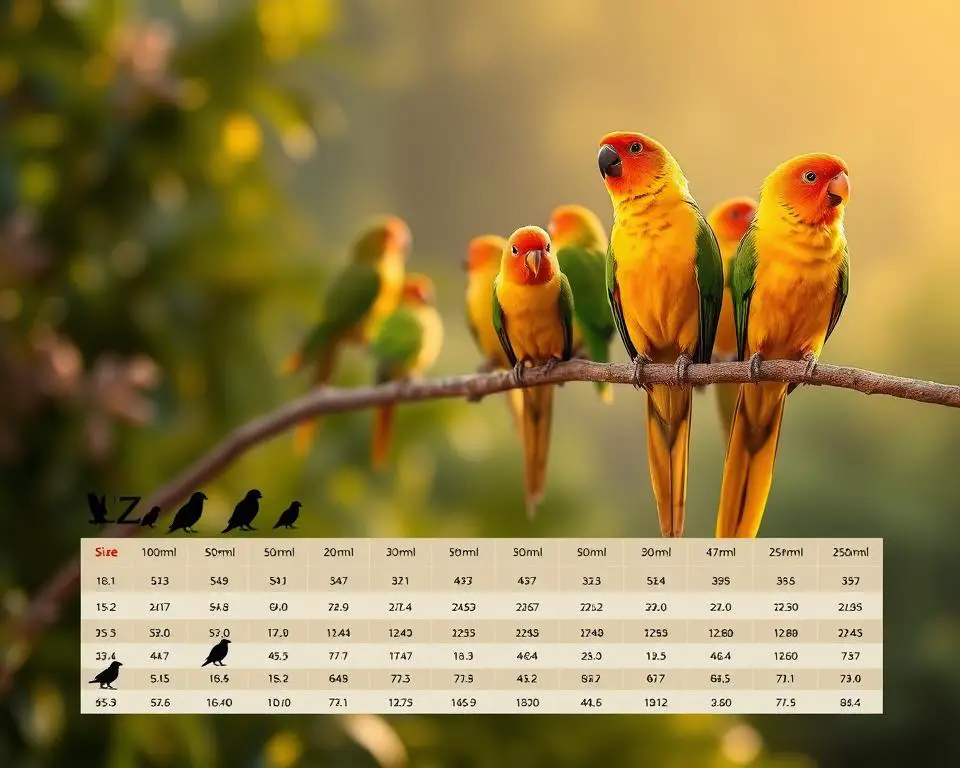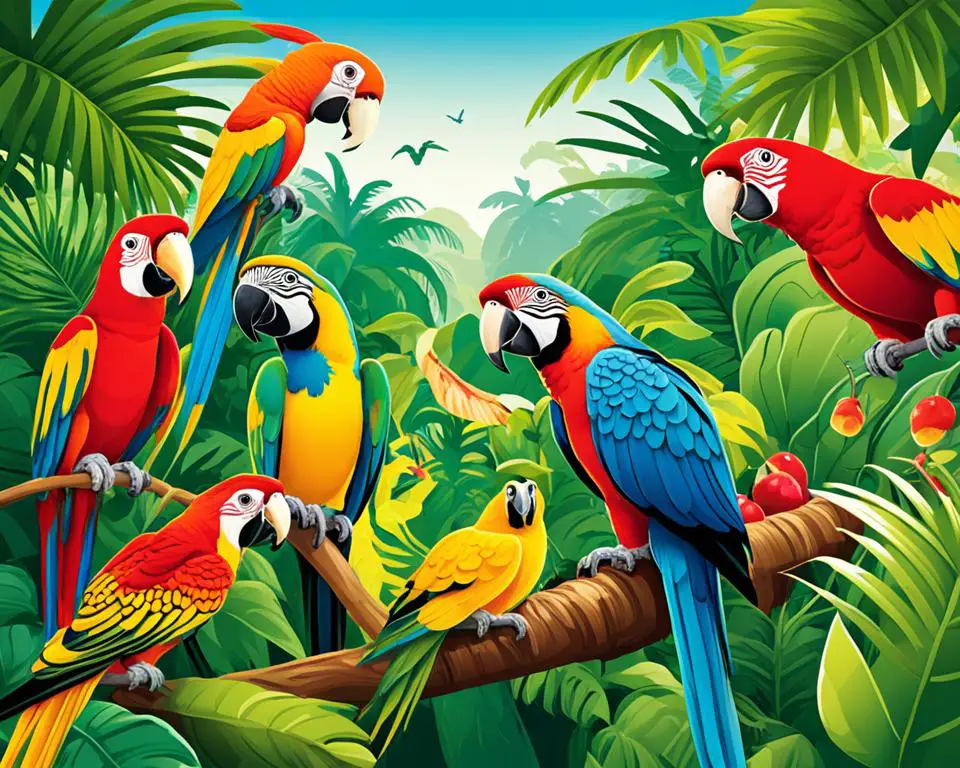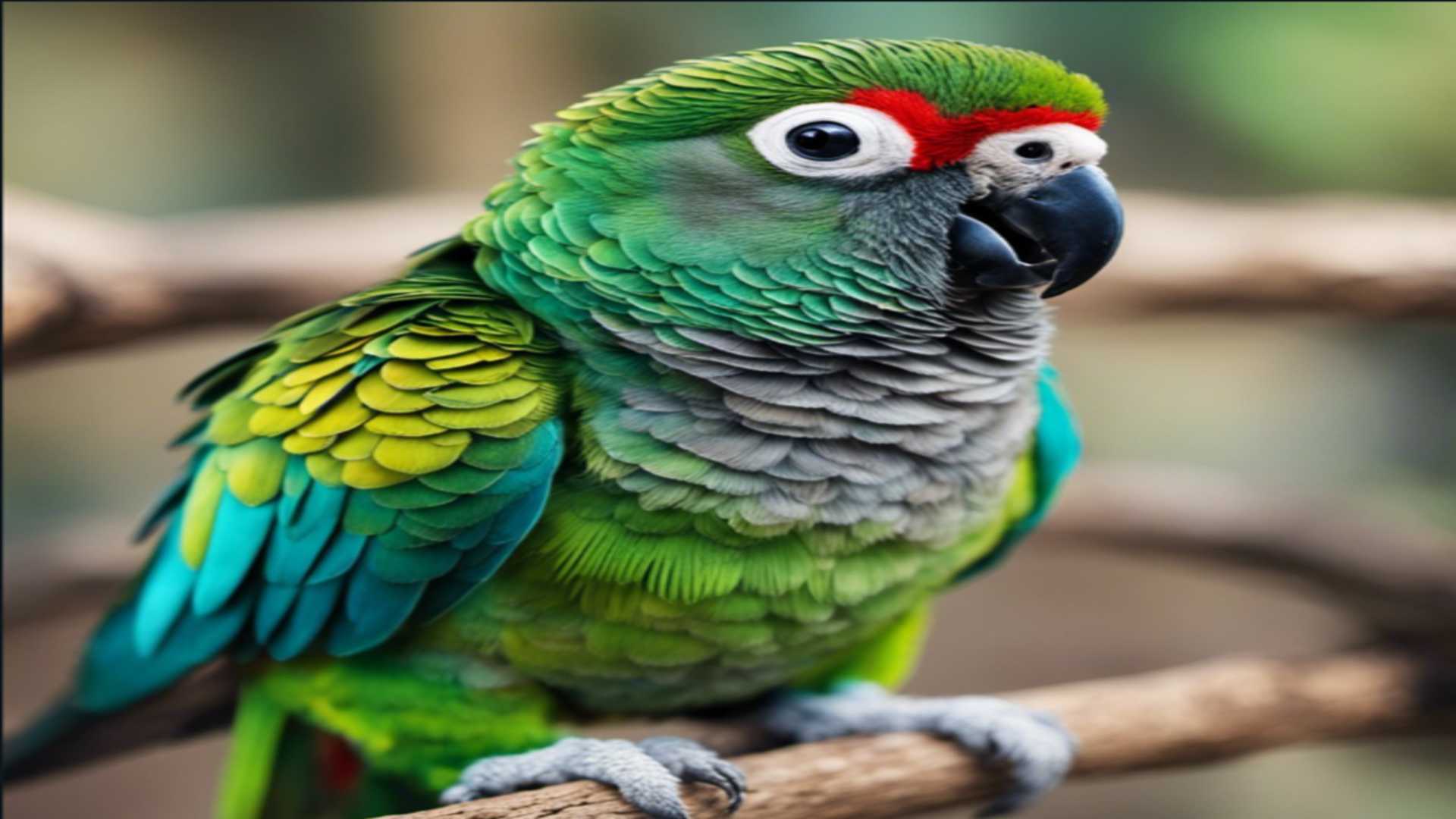Green-cheeked Conures are one of the most popular species of pet birds due to their vibrant colors and playful personalities. When choosing a pet bird, it is important to consider its gender, as it can affect its behavior.
In this article, we will discuss the physical and behavioral differences between male and female green cheek conures and how to identify each gender.
We will cover topics such as beak coloration, tail feathers, size comparison, weight variations, social habits, playing habits, eating habits, mating habits, and vocalizing habits.
By the end of this article, you will be equipped with the knowledge to identify the gender of your green cheek conure and understand how it may behave differently based on its gender.
Ready? If so, let’s get started!
Green Cheek Conure Male Vs. Female Behavior: Overview
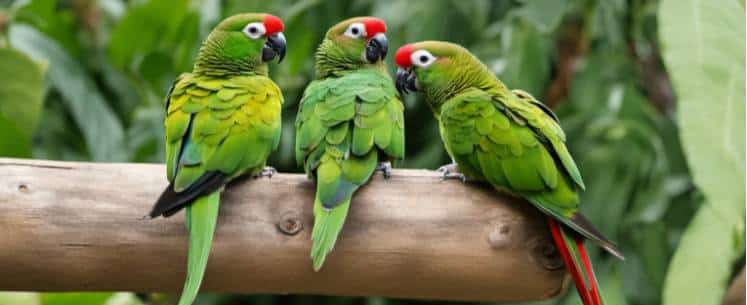
Green Cheek Conures are small, colorful parrots that are popular as pets due to their playful and affectionate nature. When it comes to their behavior, there are some differences between male and female Green Cheek Conures.
Male Green Cheek Conures tend to be more vocal and outgoing than females. They are also more likely to engage in playful behavior, such as hanging upside down from their perches or playing with toys.
Males are generally more social and enjoy interacting with their owners, while females can be a bit more reserved.
Female Green Cheek Conures are typically quieter and more independent than males. They are often content to entertain themselves with toys and may not seek out as much attention from their owners. However, they can still be affectionate and enjoy spending time with their human companions.
How do we differentiate between male and female conure?
When trying to differentiate between a male and female conure, look for physical traits such as the color of their feathers, the size of their body, and the shape of their head.
Also, behavioral differences can be observed, with males often being more vocal and exhibiting more territorial behaviors while females tend to be quieter and more nurturing.
Beak coloration
Beak coloration is an important factor when it comes to identifying the gender of a green cheek conure. Males typically have solid black beaks, while females tend to have brighter colors, such as blue or pink.
This difference is due to the presence of testosterone in males, which can cause changes in feather color as they reach adulthood. Also, female conures may experience hormonal changes resulting in feather fluffing or aggression toward other birds.
It’s important to note that beak coloration can also vary depending on the species of green cheek conure. For example, pineapple and blue-crowned varieties often feature brighter beaks than their cousins, such as Patagonian and gold-capped ones.
This is due to the different pigments in each bird’s feathers, affecting their overall appearance.
Tail feathers
Tail feathers are another important indicator when it comes to identifying the gender of a green-cheeked conure. Males typically have longer tail feathers than their female counterparts, and they usually appear more vibrant in color.
This difference is also due to the presence of testosterone in males, which can cause changes in feather color as they reach adulthood.
That said, female birds may experience hormonal changes resulting in feather fluffing or aggression towards other birds. The size and coloration of tail feathers can also vary depending on the species of green cheek conure.
Blue-crowned varieties often feature brighter tails than pineapple and gold-capped ones due to their different pigments. Furthermore, once a bird reaches sexual maturity, its tail feathers will become even more colorful as it develops breeding plumage.
Size comparison
The size of a green-cheeked conure can vary greatly depending on the species. On average, they weigh approximately three ounces and range from ten to 12 inches in length.
The blue-crowned variety tends to be the largest, with some individuals reaching up to 13 inches. Pineapple conures are usually slightly smaller than their blue-crowned counterparts, averaging around 11 inches in length.
Gold-capped conures are the smallest of the three species, typically measuring eight and ten inches.
Although there is some variation in size between green cheek conure species, all three types are considered small birds and make excellent pets for those living with limited space.
They are also relatively quiet compared to their larger cousins, such as macaws and cockatoos, making them an ideal choice for city dwellers or apartment dwellers with noise concerns.
Also, due to their small stature, they require less food and exercise than larger bird species, making them an economical pet option.
Weight variations
Weight variations among green cheek conures vary widely, depending on the species. Generally, blue-crowned conures are the heaviest of the three species, weighing up to three ounces when fully grown.
Pineapple conures are slightly lighter, usually maxing out around two ounces at full maturity. Gold-capped conures typically weigh between one and two ounces.
The weight difference between males and females is also noticeable in these birds—males tend to be larger and heavier than their female counterparts. This size difference becomes more apparent as they reach sexual maturity when males also tend to develop longer tails with more vibrant colored feathers.
Owners of green cheek conures need to monitor their pet’s weight by providing them with a balanced diet that includes plenty of high-quality pellets, fresh fruits and vegetables, nuts, seeds, and other bird-friendly foods.
If your bird loses too much weight or starts to look overly thin, it may be a sign there’s something wrong with its diet or environment, so it’s best to consult an avian veterinarian right away.
Why does your conure bite you?
When considering the behavior of green cheek conures, it is common for owners to wonder why their birds may bite them.
This behavior can stem from various reasons, such as feeling threatened, being territorial, or simply trying to communicate their discomfort or displeasure. It is important for conure owners to take the time to understand their bird’s body language and signals to ensure a harmonious relationship.
Building trust and establishing a bond through positive reinforcement and training can also help reduce biting tendencies in green cheek conures.
How smart are conures?
When comparing male and female Green Cheek Conure behavior, one might wonder how smart are conures in general. These small parrots are known for their intelligence and ability to learn tricks and mimic sounds.
Both male and female Green Cheek Conures are equally intelligent and can be trained to do various tasks. However, individual personality differences may also play a role in determining the intelligence level of each bird.
Overall, Green Cheek Conures are considered to be highly intelligent and playful birds that can make great companions for those willing to put in the time and effort to interact with them.
Male green cheek conure behaviour
When it comes to male green cheek conure behavior, there are certain characteristics and traits that distinguish them from their female counterparts.
Male green cheek conures tend to be more vocal and outgoing, often showing off by singing or squawking loudly.
They are also known to be more territorial and can be more aggressive towards other birds, especially if they feel threatened.
In terms of interaction with humans, male green cheek conures are usually more affectionate and cuddly. They enjoy being petted and scratched, and they may even seek out physical contact with their owners.
However, they can also be more demanding of attention and may become jealous if they feel neglected. Male green cheek conures are generally more energetic and playful than females.
They enjoy exploring their surroundings, playing with toys, and engaging in activities that stimulate both their body and mind.
Providing plenty of toys and opportunities for playtime is essential to keep them happy and healthy. Overall, understanding male green cheek conure behavior can help owners better care for and bond with their feathered friends.
Behavioral differences between males and females
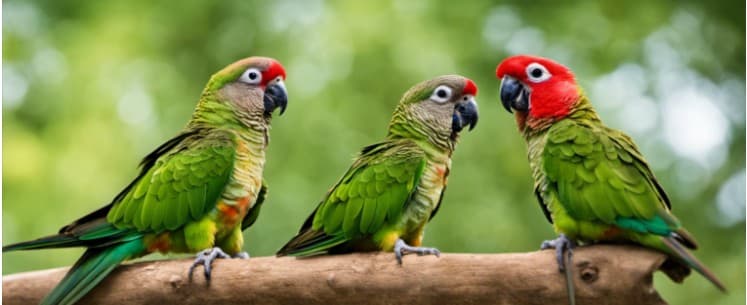
Green cheek conures are known for their playful and affectionate nature. However, there are some behavioral differences between male and female birds.
Social habits
Social habits are an essential part of green cheek conure behavior. In the wild, these birds form large flocks and spend much of their time in the company of others.
This social behavior carries over into captivity, where these birds usually prefer to have a companion, whether it be another bird or a human caretaker.
Male and female birds both exhibit social behavior, but males tend to be more active and may be more inclined to explore new environments than females. Female conures may also exhibit more ‘shy’ behavior around strangers.
Green cheek conures are very playful and enjoy interacting with their owners, often using simple vocalizations to get attention or express excitement. They also enjoy engaging in activities like swinging on ropes and toys or playing tag with other birds in the flock.
While they can be somewhat skittish around strangers, they quickly become comfortable once they get to know them.
Playing habits
Green cheek conures are known for their playful nature and love of activity. Whether it be with a human caretaker or another bird in the flock, these birds love to engage in activities like swinging on ropes, playing tag, and exploring their environment.
Both males and females exhibit playful behavior, but males tend to be more active and may be more inclined to explore new environments than females.
Green cheeks can also be very creative in how they play with objects. For example, they may take a toy and use it as a drum or shake it up and down like a maraca. Other games include pretending to fly around the room or chasing after string toys.
Playing is an important part of green cheek conure behavior as it provides them with mental stimulation, helps strengthen bonds between birds or between humans and birds, and encourages exercise, which is essential for good health.
Eating habits
Green cheek conures are omnivorous, meaning they require a balanced diet of both fruits and vegetables as well as seeds, nuts, and grains. Both male and female birds require a balanced diet, but females may experience hormonal changes resulting in feather fluffing or aggression towards other birds.
It’s important for owners to provide their birds with various foods to ensure proper nutrition. An easy way to do this is by offering fresh fruits and veggies in addition to commercially-prepared bird mixes or pellets.
Nuts like almonds can also be offered in moderation since they are high in fat content. In addition to fresh foods that should be given daily or every other day depending on the type of food it is, it’s essential to provide green cheeks with a variety of seed mixes like millet or parakeet seed mix for added nutrition.
When providing food for your green cheek conure, it’s important to remember to offer only what it can finish within 15 minutes or so.
Note: This mainly applies to fresh food items since they can spoil quickly if left out for too long.
Mating habits
Mating habits for green cheek conures vary depending on the species. Wild birds tend to form monogamous pairs that mate for life, while captive birds may or may not pair up with another bird.
Female green cheeks will typically lay 2-five eggs and incubate them for about three weeks before hatching. Once hatched, both parents will help feed and care for the young chicks until they are ready to leave the nest after 8-ten weeks.
When it comes to determining the gender of a green cheek conure, all species have different signs that can be used as indicators. Male birds generally have black beaks, while female birds tend to feature a more grayish beak coloration.
Male birds also tend to feature longer tail feathers than their female counterparts. Finally, when it comes to sexual maturity, males reach this stage at around one year old and females at two years old.
Vocalizing habits
Vocalizing habits are an important indicator when it comes to determining the gender of a green cheek conure. Male birds tend to be louder and more vocal, while females are generally quieter and less vocal. Both sexes can produce a variety of sounds, such as chirps, whistles, and screeches.
Males will also sing songs or mimic human words or phrases, while females may only do so in response to their mate’s singing.
Also, both sexes are capable of producing loud alarm calls if they feel threatened or sense danger nearby. Female green cheeks make gentler sounds compared to their male counterparts, making them ideal pets for those who want a pet bird that won’t keep them up at night with its loud chattering.
What are the signs of hormonal behavior in a male green cheek conure?
Male Green Cheek Conures can exhibit hormonal behavior during their breeding season, which typically occurs in the spring and summer months.
This behavior can include increased vocalization, territoriality, and aggression towards other birds or even their human owners. They may also become more sexually active, displaying mating behaviors such as regurgitating food or attempting to mate with objects or people.
To help manage male Green Cheek Conure’s hormonal behavior, it’s important to provide them with plenty of mental and physical stimulation, such as toys, puzzles, and regular exercise.
Limiting their exposure to nesting materials or dark, enclosed spaces can also help reduce their breeding behavior. Also, avoiding petting or touching them in areas that may be considered sexual can help prevent them from becoming overly stimulated.
It’s important to note that hormonal behavior is a natural and normal part of a male Green Cheek Conure’s reproductive cycle, and it is not a sign of aggression or misbehavior.
At what age do conures get hormonal?
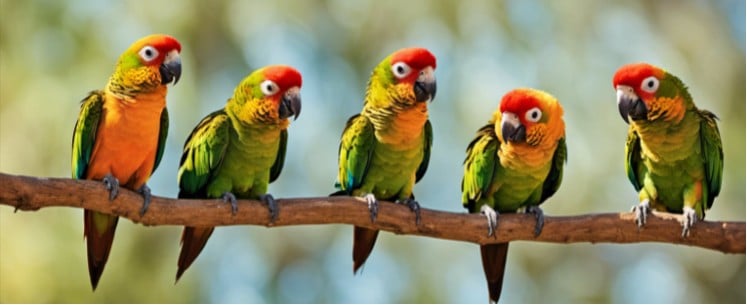
When a conure reaches sexual maturity, which usually occurs between 1 and 3 years of age, they may start to exhibit hormonal behavior. This behavior is usually most noticeable during the breeding season, which typically occurs in the spring and summer months.
During this time, male conures may become more territorial and aggressive towards other birds or even their human owners, and they may also become more vocal and sexually active.
One of the most common signs of hormonal behavior in male conures is increased vocalization.
They may start to make more noise than usual, especially in the morning and evening, and they may also start to make mating calls or other vocalizations that are associated with breeding behavior.
Male conures may also become more territorial during their breeding season, and they may become more aggressive towards other birds or even their human owners.
This aggression can manifest as biting, lunging, or other aggressive behaviors, and it can be a sign that the bird is feeling stressed or threatened.
In addition to increased vocalization and aggression, male conures may also display mating behaviors such as regurgitating food or attempting to mate with objects or people.
This behavior can be problematic, especially if the bird becomes fixated on a particular object or person, and it can be difficult to discourage once it has started.
How can you manage hormonal behaviors in male green cheek conures?
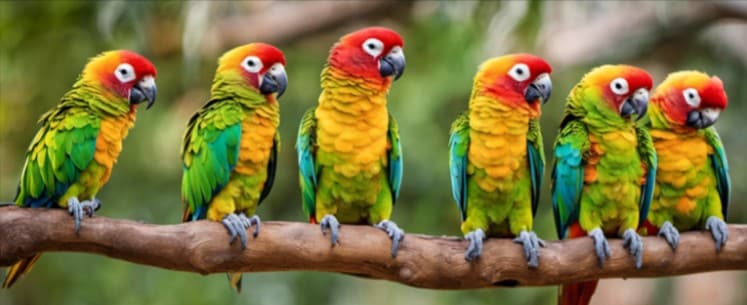
To help manage hormonal behavior in male conures, it’s important to provide them with plenty of mental and physical stimulation, such as toys, puzzles, and regular exercise.
Limiting their exposure to nesting materials or dark, enclosed spaces can also help reduce their breeding behavior. Also, avoiding petting or touching them in areas that may be considered sexual can help prevent them from becoming overly stimulated.
Summary
Before we move on to the conclusion, we’ve summarized this article into a short list of key points for you to remember:
- Green cheek conures come in varying sizes and appearances depending on the species.
- Gender can be determined by physical characteristics such as tail feathers, beak coloration, and size.
- Males typically have longer tail feathers and black beaks, while females may have shorter, rounded tails and more colorful beaks with hues of blue or pink.
Conclusion
In this article, we discussed the differences between male and female green cheek conures. We highlighted key information such as eating habits, mating habits, and vocalizing habits that can help owners determine the gender of their green cheek conure.
Both sexes are equally capable of providing companionship to their owners and make great pets for those who want a colorful bird with a great personality.
Want to learn more about chinchillas?
Ready to boost your knowledge to the next level? If so, check out the articles below:
- Do Conures Bite? (Here’s What to Do)
- Conure Chirping Meanings ( With Video)
- Can a Sun Conure Breed With a Cockatiel? (Explained for Beginners)

